RESEARCH
Development assistance for health in Africa: are we telling the right story?
L'aide au développement pour la santé en Afrique: racontons-nous la bonne histoire?
La ayuda al desarrollo en el ámbito de la salud en África: ¿estamos contando la historia correcta?
Nathalie Van de Maele*; David B Evans; Tessa Tan-Torres
Department of Health Systems Financing, World Health Organization, 20 avenue Appia, 1211 Geneva 27, Switzerland
ABSTRACT
OBJECTIVE: To describe the different types of data sets on aid flows, what they capture and the types of questions they answer, and to explore the extent of variation in levels and trends between these data sets at the regional and country levels.
METHODS: Data included in the database of the World Health Organization are derived from official country documents and are published annually after review by each country. In addition to such data, the authors extracted data from publicly available web sites. The data extracted covered all aid flows from all donors specified for sub-Saharan African countries (including aid for the African region as a whole or for groups of countries in the region) as being for health.
FINDINGS: The variation in levels and trends in development assistance for health across the six data sets compared in this paper was substantial. Variation was greater at the country than at the regional level, partly because the different aggregates of development assistance for health have different meanings and partly because of incomplete reporting.
CONCLUSION: It is important to know what the different aggregates of development assistance for health reported in the different databases mean before deciding which ones to use to answer a particular policy question. Using the wrong source can lead to erroneous conclusions.
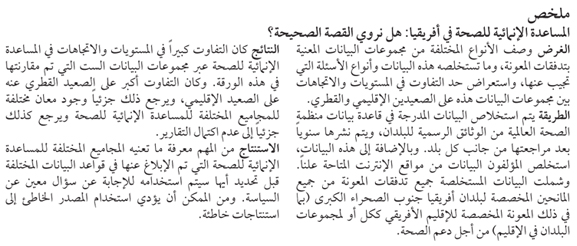

RÉSUMÉ
OBJECTIF: Décrire les différents types d'ensembles de données sur les flux d'aide, ce qu'ils identifient, les types de questions auxquelles ils répondent, et étudier l'étendue de l'écart dans les niveaux et les tendances entre ces ensembles de données aux niveaux régional et national.
MÉTHODES: Les données figurant dans la base de données de l'Organisation mondiale de la Santé sont issues de documents nationaux officiels et sont publiées chaque année, après avoir été examinées par chaque pays. Outre ces données, les auteurs ont extrait certaines informations de sites Web accessibles au public. Les données recueillies ont couvert tous les flux d'aide de tous les donateurs spécifiés pour les pays d'Afrique subsaharienne (y compris l'aide pour la région africaine dans son ensemble ou pour des groupes de pays de la région) en ce qui concerne la santé.
RÉSULTATS: L'écart des niveaux et des tendances dans l'aide au développement pour la santé à travers les six ensembles de données comparés dans ce rapport est considérable. Il était plus important au niveau des pays qu'au niveau des régions, d'une part, car les différents agrégats de l'aide au développement pour la santé ont des significations différentes, et d'autre part, en raison de déclarations incomplètes.
CONCLUSION: Il est important de savoir ce que les différents agrégats de l'aide au développement pour la santé repris dans les différentes bases de données signifient avant de décider quels sont ceux à utiliser pour répondre à une question de politique particulière. L'utilisation d'une source incorrecte pourrait conduire à des conclusions erronées.
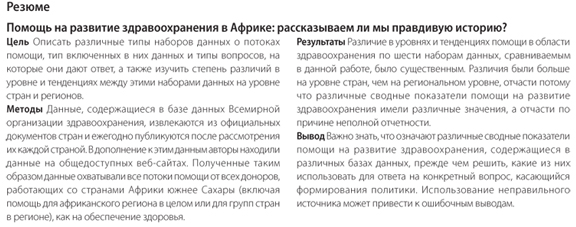
RESUMEN
OBJETIVO: Describir los distintos tipos de datos sobre los flujos de ayuda, lo que recopilan y a qué tipo de preguntas ofrecen respuesta, y explorar en qué medida varían los niveles y tendencias entre dichos datos a nivel regional y nacional.
MÉTODOS: Los datos incluidos en la base de datos de la Organización Mundial de la Salud provienen de documentos nacionales oficiales y se publican anualmente tras haber sido revisados por cada país. Además de esos datos, los autores extrajeron información disponible para el público en sitios web. La información extraída incluyó todos los flujos de ayuda de todos los donantes mencionados para los países subsaharianos (incluida la ayuda para la región africana como un todo o por grupos de países en la región), clasificada como para la salud.
RESULTADOS: La variación en los niveles y las tendencias de la ayuda para el desarrollo en el ámbito de la salud en los seis conjuntos de datos comparados en este documento fue notable. La variación fue mayor a nivel nacional que regional, en parte porque los distintos conjuntos de ayuda al desarrollo en el ámbito de la salud tienen significados diferentes y en parte porque los informes son incompletos.
CONCLUSIÓN: Es importante conocer lo que los distintos conjuntos de la ayuda al desarrollo en el ámbito de la salud registrados en las distintas bases de datos significan antes de decidir cuáles emplear para dar respuesta a una cuestión sobre una estrategia en particular. Usar una fuente equivocada puede dar lugar a conclusiones erróneas.
Introduction
The amount of research on donor financial assistance to health, commonly called development assistance for health (DAH), has increased substantially over the last decade. One focus of this research has been the extent to which DAH increased after 2000,1 when the Millennium Development Goals, in which health features so prominently, were established. 2 Others have explored the allocation of aid flows to particular health problems or geographical regions, on the basis of the argument that some health problems or countries have been neglected. 38
This work suggests that aid flows for health have more than doubled since 2000. 8,9 Private foundations, particularly the Bill & Melinda Gates Foundation (equivalent to about 20% of the development aid for health supplied by the Government of the United States of America for the period 19992010), assumed greater importance relative to the traditional bilateral and multilateral donors. Half of the additional funding between 2000 and 2009 targeted only two diseases infection with human immunodeficiency virus (HIV) and malaria. 8,9 Some countries (e.g. Botswana, Zambia) benefited a great deal, but others (e.g. Cameroon, Guinea, Nigeria) were less fortunate and came to be called "aid orphans". 9,10
Attention then turned to how recipient countries have reacted to increased financial inflows for health. The results of this suggest that they reallocated some of their own domestic resources away from health to other sectors following DAH inflows. 1113 Other work shows, on the other hand, that aid flows impose substantial costs on recipient countries, partly because each donor has a different application, monitoring and reporting requirement. 3
Other questions include how increases in DAH affect macroeconomic stability (e.g. inflation)14 and health outcomes15 and whether DAH will fall as a result of the continuing global financial crisis. 16 Preliminary results suggest that official development assistance (ODA) has remained stable since 2008 (in constant prices), whereas DAH by foundations and nongovernmental organizations (NGOs) has decreased since 2010. 8,9 ODA is: "flows provided by government official agencies, and administered with the promotion of the economic development and welfare of developing countries as its main objective". ODA represents about 70% of total DAH. 17
These questions are undoubtedly interesting. However, the peculiarities in the way financial flows are reported and collated means that the data used to answer them are not always the most appropriate. The fragmented reporting of DAH precludes the availability of a comprehensive source of data capturing all sources of aid. 18,19 In addition, the different ways in which aid flows are reported can cause confusion. Some of the studies above have based their analyses on information on donor commitments; others have done so using data on disbursements. Still others have used data on health expenditures in recipient countries that are financed from external sources.
Accordingly, this paper first describes the various types of data that are available on DAH, as well as their strengths and weaknesses. It then takes examples from specific countries to illustrate the difference that the type of data makes. Based on these findings, in the concluding section we make recommendations on the types of data that should be used to conduct different types of analyses.
Methods
Commitments, disbursements and expenditures
Commitments are financially-backed written documents in which donors undertake to provide financial assistance to recipient countries directly or through multilateral organizations. Most of the time, commitments are pledged for multiple years. 17
Disbursements are the amount of aid transferred from donors, in cash, in kind (valued at the cost to the donor) or in services. Funds are considered spent from the point of view of the donor, regardless of whether the recipient has spent them in the year in which they are disbursed. Disbursements in any given year usually represent only part of an earlier commitment depending on the donor's planning cycle (which can be up to 10 years). 20
Country programmable aid (CPA)17 started being reported by donors in 2004 to capture how much of each reported disbursement was available for spending within a recipient country, rather than on global activities or activities linked to health aid in the donor country e.g. health research, health of asylum seekers. Data are not available for all donors, particularly the private foundations and some of the non-traditional donors that are not members of the Organisation for Economic Co-operation and Development (OECD).
The last category is health expenditure in recipient countries that has its origin in external sources, referred to in this paper as DAH expenditure. It is captured through national health accounts (NHAs), an accounting framework for monitoring trends in health spending. 21 NHAs include expenditures in the country originating from domestic and external sources.
Data
To illustrate how these different categorizations of DAH tell different stories, we accessed online data for 19952011for sub-Saharan Africa, the region that receives the world's largest share of DAH. We obtained these data from different sources' web sites.
We obtained data on commitments, disbursements and CPA from the largest repository, the databases of the Creditor Reporting System (CRS) of the OECD's Development Assistance Committee (OECD DAC). For commitments, data were available for 19952011; for disbursements, they were available for 20022011; for CPA, they were available for 20042011. The OECD has traditionally mandated the reporting of aid flows from the 23 bilateral donors of the OECD DAC. 22 Recently, several other countries and agencies have begun to report to the OECD DAC voluntarily: since 2009, two non-OECD bilateral donors (Kuwait and the United Arab Emirates) and one private donor, the Bill & Melinda Gates Foundation; and earlier, multilateral agencies such as the Global Fund to Fight AIDS, Tuberculosis and Malaria (2003) and the GAVI Alliance (2007). The database of the OECD DAC CRS does not include data from many of the emerging donors (e.g. the BRICS countries Brazil, the Russian Federation, India, China and South Africa; OECD countries that are not members of the DAC, such as Turkey and the Czech Republic; other donors from the Middle East; or emerging donors, such as Colombia). 23
Country-level data on expenditures from external sources were taken from the World Health Organization's Global Health Expenditure Database (GHED), updated each year after considerable interaction with countries. 24 Data were available for 19952011. For illustrative purposes we have chosen countries where full NHA studies were available to avoid complicating the comparisons with extrapolations made for missing data in the GHED.
Other data sources include the Institute of Health Metrics Evaluation (IHME) disbursements data, based largely on OECD DAC data but complemented with data from multilateral agencies, United States foundations and large nongovernmental organizations in the United States. The OECD DAC data is adjusted using the IHME's own calculations. This source does not include flows from emerging donors. Data by recipient country were available for 19952010.
The AidData initiative complements the OECD's data on commitments with aid flows from emerging donors and multilaterals data from private donors are not yet included and with more detailed breakdown information on how funds are spent. 25 It has only limited series on disbursements. Commitment data were available for 19952009.
Results
Discrepancies from recipients' viewpoint
Although DAH has unquestionably more than doubled since the early 2000s, regardless of the data source or of the definition of DAH applied reported commitments, disbursements, CPA or domestic expenditures large differences exist in the absolute values of reported aid between data sources (Fig. 1). For sub-Saharan Africa, the expenditure of external sources reported through NHAs is consistently lower than commitments (around 25%) and disbursements (around 15%), and CPA is slightly lower than disbursements. IHME estimates are very close to reported OECD disbursements and CPA because of the difficulty, recognized by the IHME, of identifying the destination of the aid flowing from their additional donors to specific recipients by sector.
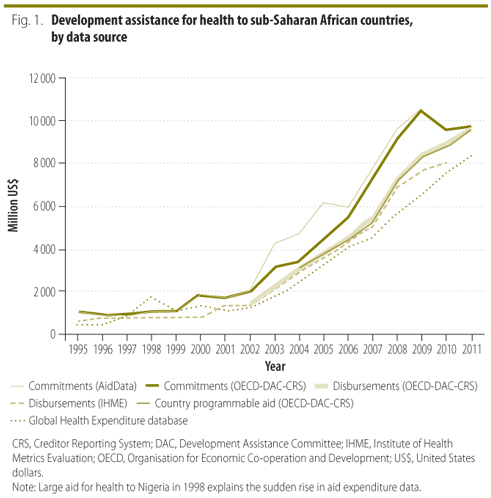
The different sources also report on different time periods. A reliable series on disbursements has existed only since 2002, whereas CPA has only been reported since 2004. The series on commitments and on domestic health expenditures from aid have existed for longer. Accordingly, IHME disbursements data for years before 2002 rely on backward projections based on the estimated relationship between commitments and disbursements since 2002. 8
These differences in levels and trends become even more apparent when data for specific recipient countries are examined. Zambia and Burkina Faso (Fig. 2 and Fig. 3) are good illustrations of these differences. CPA is not reported because the series is so close to CRS disbursements that reading the graphs would be difficult.
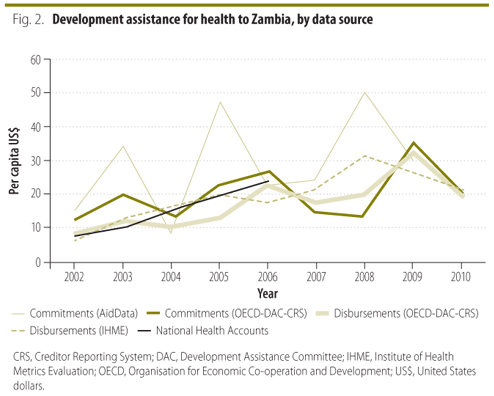
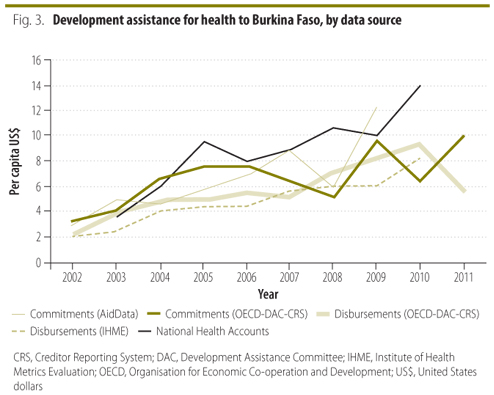
Although reported commitments, disbursements, and expenditures for Zambia show an overall positive trend, the levels and directions of the aid in specific years show wide variations, even for the same aid category (e.g. commitments). For example, the DAH expenditure reported for the four years of NHA data continued to increase at a constant rate despite the rises and falls in commitments and disbursements reported to the OECD. AidData and CRS commitments are, at times, moving in opposite directions; one source shows an increase in DAH while the other shows a decrease.
Reported commitments and disbursements in Burkina Faso move in opposite directions in several years and IHME disbursement data are generally lower than disbursement data from the CRS. Strikingly, the reported DAH computed from NHA studies is higher than commitments and disbursements reported by other sources (about 45% more than reported disbursements). The difference comes from aid in-kind provided by pharmaceutical companies, which does not appear in any of the other data sources.
NHA data often show health expenditures from DAH to be higher than reported donor disbursements and CPA in the OECD database. This is consistently the case for four of the 13 sub-Saharan African countries with more than one recent NHA study. Two show the opposite (e.g. that domestic health spending from external sources is always lower than shown in OECD reports on disbursements and CPA), whereas seven show mixed results (e.g. that expenditures according to OECD data are sometimes greater than and sometimes less than the DAH expenditures tracked in NHA studies).
Discrepancies at the donor country level
This variability between sources is also evident when DAH from individual donors is examined. Typically commitments made by individual donors fluctuate from year to year much more than do disbursements. Commitments are entirely recorded in the year when the promise is made and are typically intended to be fully disbursed over several subsequent years. CPA may or may not follow the same trend as disbursements, as illustrated in Fig. 4 and Fig. 5 for Norway and the United Kingdom of Great Britain and Northern Ireland, respectively. This is because donors can vary the share of disbursements retained for development-related activities in the home country.
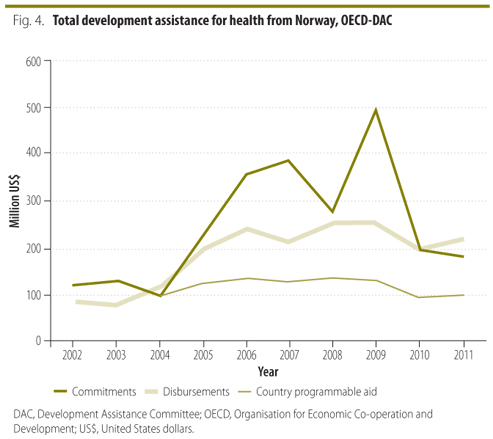
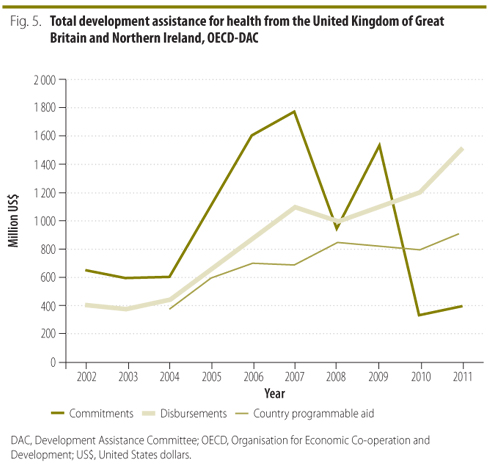
Discrepancies in allocations
Other discrepancies emerge when the lowest and highest recipients of aid are examined. Table 1 and Table 2 show the lowest and highest recipients for 20022010 according to the three types of DAH. Mauritania is among the bottom 10 recipients in terms of donor commitments to health but falls to 20th position in the disbursements and expenditure data sets. The median country is ranked at the 24th position, so Mauritania does not do much worse than the median country in terms of donor funds that are actually spent in the country.
The United Republic of Tanzania would not be considered among the top 10 recipients of aid on the basis of information on commitments or disbursements. However, it is one in terms of DAH expenditures at the country level. Liberia, on the other hand, is among the top 10 recipients in terms of commitments and disbursements, but not when it comes to the DAH expenditures reported by the NHAs.
Part of the observed differences between the various aggregates of DAH can be explained by differences in the comprehensiveness of each data repository. Table 3 highlights the differences between the various sources in terms of data "completeness", which is linked to whether reporting is mandatory. We also show which sources allow an expenditure breakdown by disease or health-related MDG.
No data source is fully complete. In theory, NHAs should capture all sources of domestic health expenditures, but not all countries produce them regularly. The GHED, although based on reported country expenditures, uses projections or estimates to fill in missing data for countries that do not report all types of health expenditures annually. The other databases still do not comprehensively capture DAH from non-traditional donors and cannot identify how much of the aid reported by donors actually arrives in a country for the country to spend.
Discussion
Some important conclusions and recommendations emerge from our findings. First, the differences between the various aggregates of DAH and sources of data are less important at the global and regional levels, but they matter more when trying to understand trends in aid from a particular donor or to a particular recipient country. Second, criticisms of the volatility of donor funding for health have sometimes relied on an analysis of either commitments or disbursements. 18,29 Commitments are promises for the future that are recorded in the year in which they are made, but the amount committed is to be disbursed over several years. Commitments are inherently lumpy (i.e. intermittent) and cannot be used to assess the volatility of DAH. Year-to-year fluctuations in disbursements are less dramatic, especially at the global and regional levels, and fluctuations in DAH expenditures are generally even smaller. Third, neither commitments nor disbursements reflect the financial resources arriving in a recipient country for its use in improving health. Commitments include a component, often substantial, that is never intended to be used in the recipient country. Disbursements reported by donors also include funding that remains in the donor country to cover expenses related to development assistance, such as the health costs of foreign students or the cost of donor country think tanks.
CPA was developed to account for these discrepancies. However, a substantial gap remains between the CPA reported by donors and the data on expenditures of aid by countries derived from NHAs because CPA still includes items that are spent in the donor country. Similarly, CPA (and disbursements and commitments) often differs from DAH expenditures at the country level because of the increase in non-traditional donors (such as China and India) that do not report to the OECD. Accordingly, the question of how donor support for health is spent within the recipient country needs to be answered by using NHA data. This also applies to questions surrounding the fungibility or additionality of domestic expenditures as a result of aid inflows.
The confusion generated by the different aggregates and sources of data can be cleared by institutionalizing reporting standards more in tune with the multiple information needs of policy-makers, researchers and civil society. The OECD encourages all donors to voluntarily report to it, but it cannot obligate non-OECD members, foundations, NGOs or the private sector to do so. WHO and institutions such as the Joint United Nations Programme on HIV/AIDS and the World Bank, as well as global initiatives such as the Commission on Information and Accountability for Women's and Children's Health, have been working with countries for many years to institutionalize the production and reporting of national health expenditures, but more effort is needed to facilitate comprehensive reporting by donors at the country level. The money spent to improve health within countries is what will allow them to get closer to attaining the Millennium Development Goals and their successors. 
Competing interests: None declared.
References
1. Organisation for Economic Co-operation and Development, Development Co-operation Directorate [Internet]. Measuring aid to health. Paris: OECD DAC; 2009. Available from: www.oecd.org/dataoecd/44/35/44070071.pdf [accessed 31 March 2013] .
2. Resolution 55/2. United Nations Millennium Declaration. In: United Nations General Assembly [Internet]. Resolutions adopted by the United Nations General Assembly at its 55th session; New York; 2000 68 September. Available from: www.un.org/millennium/declaration/ares552e.htm [accessed 31 March 2013] .
3. Piva P, Dodd R. Where did all the aid go? An in-depth analysis of increased health aid flows over the past 10 years. Bull World Health Organ 2009;87:9309. doi: http://dx.doi.org/10.2471/BLT.08.058677 PMID: 20454484
4. Ravishankar N, Gubbins P, Cooley RJ, Leach-Kemon K, Michaud CM, Jamison DT et al. Financing of global health: tracking development assistance for health from 1990 to 2007. Lancet 2009;373:211324. doi: http://dx.doi.org/10.1016/S0140-6736(09)60881-3 PMID: 19541038
5. Shiffman J. Has donor prioritization of HIV/AIDS displaced aid for other health issues? Health Policy Plan 2008;23:95100. doi: http://dx.doi.org/10.1093/heapol/czm045 PMID: 18156161
6. The Global Fund To Fight AIDS, Tuberculosis and Malaria [Internet]. The five-year evaluation of the Global Fund to Fight AIDS, TB and Malaria: synthesis of study areas 1, 2 and 3; Geneva: Global Fund; 2009. Available from: www.theglobalfund.org/documents/terg/TERG_FiveYearEvaluation05_Brief_en/ [accessed 31 March 2013] .
7. Suhrcke M, Rechel B, Michaud C. Development assistance for health in central and eastern European region. Bull World Health Organ 2005;83:9207. PMID: 16462984
8. Institute for Health Metrics and Evaluation. Financing global health 2012: the end of the golden age? Seattle: IHME; 2012.
9. Organisation for Economic Co-operation and Development, Development Co-operation Directorate [Internet]. Creditor Reporting System database. Paris: OECD DAC; 2013. Available from: http://stats.oecd.org/Index.aspx?datasetcode=CRS1 [accessed 31 March 2013] .
10. Rogerson A, Steensen S. Aid orphans: whose responsibility? OECD Development Brief 2009;1. Available from: www.oecd.org/dataoecd/14/34/43853485.pdf [accessed 8 April 2013] .
11. Stuckler D, Basu S, McKee M. International Monetary Fund and aid displacement. Int J Health Serv 2011;41:6776. doi: http://dx.doi.org/10.2190/HS.41.1.e PMID: 21319721
12. Lu C, Schneider MT, Gubbins P, Leach-Kemon K, Jamison D, Murray CJL. Public financing of health in developing countries: a cross-national systematic analysis. Lancet 2010;375:137587. doi: http://dx.doi.org/10.1016/S0140-6736(10)60233-4 PMID: 20381856
13. Farag M, Nandakumar AK, Wallack SS, Gaumer G, Hodgkin D. Does funding from donors displace government spending for health in developing countries? Health Aff (Millwood) 2009;28:104555. doi: http://dx.doi. org/10.1377/hlthaff.28.4.1045 PMID: 19597203
14. Cavagnero E, Lane C, Evans DB, Carrin G. Development assistance for health: should policy-makers worry about its macroeconomic impact? Bull World Health Organ 2008;86:86470. doi: http://dx.doi.org/10.2471/BLT.08.053090 PMID: 19030692
15. Flaxman AD, Fullman N, Otten MW Jr, Menon M, Cibulskis RE, Ng M et al. Rapid scaling up of insecticide-treated bed net coverage in Africa and its relationship with development assistance for health: a systematic synthesis of supply, distribution, and household survey data. PLoS Med 2010;7:e1000328. doi: http://dx.doi.org/10.1371/journal.pmed.1000328 PMID: 20808957
16. Stuckler D, Basu S, Wang SW, McKee M. Does recession reduce global health aid? Evidence from 15 high-income countries, 19752007. Bull World Health Organ 2011;89:2527. doi: http://dx.doi.org/10.2471/BLT.10.080663 PMID: 21479089
17. DAC glossary of key terms and concepts [Internet]. Paris: Organization for Economic Co-operation and Development, Development Co-operation Directorate; 2013. Available from: http://www.oecd.org/dac/dacglossaryofkeytermsandconcepts.htm#ODA [accessed 8 April 2013] .
18. McCoy D, Chand S, Sridhar D. Global health funding: how much, where it comes from and where it goes. Health Policy Plan 2009;24:40717. doi: http://dx.doi.org/10.1093/heapol/czp026 PMID: 19570773
19. Organization for Economic Co-operation and Development. Chapter 4: Improving predictability and transparency of aid to the health sector. In: Aid effectiveness in the health sector: progress and lessons. Paris: OECD; 2012. Available from: http://www.oecd-ilibrary.org/fr/development/progress-and-challenges-in-aid-effectiveness_9789264178014-en;jsessionid=2p662y9x7kbdm.delta [accessed 31 March 2013] .
20. Organization for Economic Co-operation and Development. Chapter 5: Aid predictability and transparency. In: Aid effectiveness 2005-10: progress in implementing the Paris Declaration. Paris: OECD; 2011. Available from: http://www.aideffectiveness.org/busanhlf4/images/stories/hlf4/Progress_Since_ Paris_Part_I.pdf [accessed 31 March 2013] .
21. World Health Organization [Internet]. National Health Accounts. Geneva: WHO; 2013. Available from: http://www.who.int/nha [accessed 31 March 2013] .
22. Organisation for Economic Co-operation and Development, Development Co-operation Directorate [Internet]. DAC members: dates of membership and websites. Paris: OECD DAC; 2013. Available from: http://www.oecd.org/dac/dacmembersdatesofmembershipandwebsites.htm [accessed 8 April 2013] .
23. Smith K, Yamashiro Fordelone T, Zimmermann F. Beyond the DAC: the welcome role of other providers of development co-operation. Paris: Organisation for Economic Co-operation and Development; 2010. Available from: www.oecd.org/dac/45361474.pdf [accessed 8 April 2013] .
24. World Health Organization [Internet]. Global Health Expenditure Database. Geneva: WHO; 2013. Available from: http://apps.who.int/nha/database/DataExplorerRegime.aspx [accessed 25 March 2013] .
25. AidData [Internet]. AidData coverage metrics, by country/organization. Washington: AidData; 2013. Available from: http://www.aiddata.org/content/index/user-guide/Sources-and-Coverage [accessed 8 April 2013] .
26. AidData [Internet]. Data sources and coverage. Washington: AidData; 2013. Available from: http://www.aiddata.org/content/index/user-guide/Sources-and-Coverage [accessed 8 April 2013] .
27. AidData [Internet]. Sector and activity coding scheme. Washington: AidData; 2013. Available from: http://www.aiddata.org/content/index/user-guide/coding-scheme [accessed 8 April 2013]
28. The World Bank [Internet]. Promoting the institutionalization of national health accounts: global consultation. Washington: WB; 2010. Available from: http://www.hha-online.org/hso/system/files/page/2010/11/consultation_summary_final.pdf. [accessed 1 April 2013] .
29. Desai RM, Kharas H. The determinants of aid volatility (Global Economy and Development Working Paper 42). Washington: Brookings Institute; 2010. Available from: http://www.brookings.edu/~/media/research/files/papers/2010/9/aid%20volatility%20desai%20kharas/09_aid_volatility.pdf [accessed 1 April 2013] .
(Submitted: 19 November 2012 Revised version received: 20 March 2013 Accepted: 21 March 2013 Published online: 8 April 2013)
* Correspondencia to Nathalie Van de Maele (e-mail: vandemaelen@who.int).
